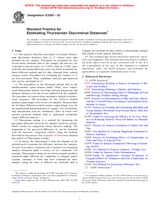Potřebujeme váš souhlas k využití jednotlivých dat, aby se vám mimo jiné mohly ukazovat informace týkající se vašich zájmů. Souhlas udělíte kliknutím na tlačítko „OK“.
ASTM E2262-03
Standard Practice for Estimating Thurstonian Discriminal Distances
Automaticky přeložený název:
Standardní praxe pro odhad Thurstonian Discriminal Vzdálenosti
NORMA vydána dne 10.7.2003
Informace o normě:
Označení normy: ASTM E2262-03
Poznámka: NEPLATNÁ
Datum vydání normy: 10.7.2003
Kód zboží: NS-44838
Počet stran: 47
Přibližná hmotnost: 141 g (0.31 liber)
Země: Americká technická norma
Kategorie: Technické normy ASTM
Anotace textu normy ASTM E2262-03 :
Keywords:
distances, discriminal, Thurstonian, ICS Number Code 67.240 (Sensory analysis)
Doplňující informace
| 1. Scope | ||||||||||||||||||||||||||||||||
|
1.1 This practice describes procedures to estimate Thurstonian discriminal distances (that is, d' values) from data obtained on two samples. Procedures are presented for four forced-choice methods (that is, the triangle, the duo-trio, the 3-alternative-forced-choice (or 3-AFC) and the 2-AFC (also called the directional difference test)), the A/Not-A method, the Same-Different method and for data obtained from ordered category scales. Procedures for estimating the variance of d' are also presented. Thus, confidence intervals and statistical tests can be calculated for d'. 1.2 The procedures in this document pertain only to the unidimensional, equal-variance model. Other, more complicated Thurstonian models, involving multiple dimensions and unequal variances exist but are not addressed in this standard. The procedure for forced-choice methods is limited to dichotomous responses. The procedure for the A/Not-A method assumes equal sample sizes for the two samples. The procedure for the Same-Different method assumes equal sample sizes for the matched and unmatched pairs of samples. For all methods, only unreplicated tests are considered. (Tests in which each assessor performs multiple (that is, replicated) evaluations require different analyses.) 1.3 Thurstonian scaling is a method for measuring the perceptual difference between two samples based on a probabilistic model for categorical choice decision making. The magnitude of the perceived difference, δ, can be estimated from the assessors' categorical choices using the methods described in this practice (See Appendix X3 for a more detailed description of Thurstonian scaling). 1.4 In theory, the Thurstonian does not depend on the method used to measure the difference between two samples. As such, δ provides a common scale of measure for comparing samples measured under a variety of test conditions. For example, Thurstonian scaling can be used to compare products measured under different test conditions, to compare panels (trained, consumer or both) that have evaluated the same samples (using the same or different test methods) and to compare test methods on their ability to discriminate samples that exhibit a fixed sensory difference. 1.5 This standard may involve hazardous materials, operations and equipment. This standard does not purport to address all of the safety concerns, if any, associated with its use. It is the responsibility of the user of this standard to establish appropriate safety and health practices and determine the applicability of regulatory limitations prior to use. |
||||||||||||||||||||||||||||||||
| 2. Referenced Documents | ||||||||||||||||||||||||||||||||
|
Doporučujeme:
Aktualizace technických norem
Chcete mít jistotu, že používáte pouze platné technické normy?
Nabízíme Vám řešení, které Vám zajistí měsíční přehled o aktuálnosti norem, které používáte.
Chcete vědět více informací? Podívejte se na tuto stránku.




 Cookies
Cookies
